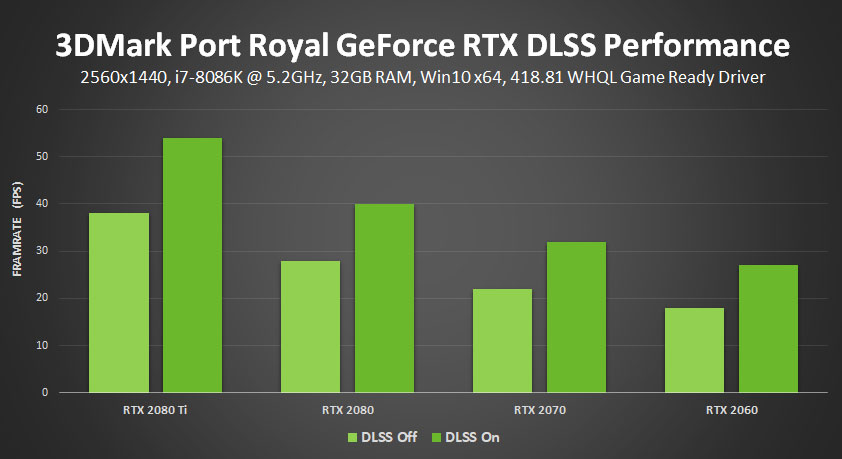Nvidia’s latest GPU driver enables DLSS in 3DMark for big performance gains
This is the promise of DLSS.

Nvidia has a new 418.81 WHQL driver package available, and while this latest release doesn't deliver any "Game Ready" optimizations for specific games, it does further hype the promise of DLSS.
DLSS, or Deep Learning Super Sampling, is a rendering technique that is one of the staple features of Nvidia's Turing GPU architecture, and by extension, its GeForce RTX series graphics cards. The pitch is that it delivers pretty visuals and faster performance than anti-aliasing at QHD and 4K resolutions. It attempts to achieve this through machine learning.
"First, we show a neural network thousands of screen captures from each DLSS game that are up to 64x Super Sampled (64xSS), and then another set of images captured without anti-aliasing. We then task the network with reviewing and comparing the shots, to learn how to approximate the quality of 64xSS without its immense performance cost," Nvidia explains.
"As the network repeats the process its algorithms are tweaked, and eventually it learns to automate the process, delivering anti-aliasing approaching the quality of 64xSS, whilst avoiding the issues associated with TAA, such as screen-wide blurring, motion-based blur, ghosting, and artifacting on transparencies," Nvidia adds.
One of the main issues is the lack of supported games. That will likely change in time (FFXV is the only game with DLSS support right now, though BF5 should get it soon), though in the meantime, the newest driver release enables DLSS support in 3DMark's Port Royal benchmark. UL Benchmarks developed Port Royal specifically to test real-time ray tracing performance.

According to Nvidia, DLSS in Port Royal improves performance by up to 50 percent, and increases framerates across its complete range of GeForce RTX cards.
"What’s more, DLSS also enhances image quality in Port Royal thanks to the power of deep learning. Anti-aliasing is improved, detail is sharper, and game elements seen through transparent surfaces are vastly improved," Nvidia says.
Keep up to date with the most important stories and the best deals, as picked by the PC Gamer team.
Nvidia also uploaded a two-and-a-half-minute video to YouTube to show the difference in performance and visual quality. Check it out:
DLSS is certainly promising, and what we have here is Nvidia putting the technology's best foot forward. If you want to run it for yourself, you'll of course need a GeForce RTX series graphics card. You'll also need a copy of Port Royal, Windows 10 version 1809 or higher, and the latest 418.81 driver release, which you can download here.
For everyone else, Nvidia posted several interactive sample photos that allow you to compare the image quality of Port Royal with and without DLSS enabled. Keep in mind that the "DLSS Off" results are using heavy temporal AA in a way that overly blurs many scenes.
Paul has been playing PC games and raking his knuckles on computer hardware since the Commodore 64. He does not have any tattoos, but thinks it would be cool to get one that reads LOAD"*",8,1. In his off time, he rides motorcycles and wrestles alligators (only one of those is true).



